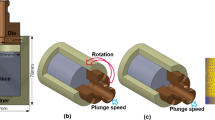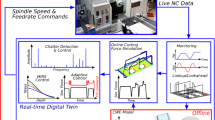Abstract
The objective of manufacturing technology, to reduce machining costs, increase product quality and optimize process setups, is only achievable by considering the entire manufacturing process and its interrelations. Especially in tool grinding, strong interactions exist between workpiece dynamics, grinding wheel engagement, structure deformations and cutting process conditions, which makes an integrated model necessary. This paper introduces a tool grinding model that combines time-dependent dynamical aspects of the grinding wheel and workpiece with local varying contact conditions to predict the final workpiece geometry and cutting forces with a high resolution in space and time. The model is capable to reproduce systemic effects on cutting forces and ground geometries which only occurs in the interplay of all system components. The model is also positively tested in representing influences of process parameters and in optimizing the machining. The excellent agreement of simulations and experimental data shows the model’s potential in manufacturing technology, but also in investigating grinding aspects, which are not fully understood yet.












Similar content being viewed by others
References
Altintas Y, Brecher C, Weck M, Witt S (2005) Virtual machine tool. CIRP Ann-Manuf Technol 54(2):115–138. doi:10.1016/S0007-8506(07)60022-5
Altintas Y, Kersting P, Biermann D, Budak E, Denkena B, Lazoglu I (2014) Virtual process systems for part machining operations. CIRP Ann-Manuf Technol 63(2):585–605. doi:10.1016/j.cirp.2014.05.007
Altintas Y, Weck M (2004) Chatter stability of metal cutting and grinding. CIRP Ann-Manuf Technol 53(2):619–642. doi:10.1016/S0007-8506(07)60032-8
Aurich JC, Biermann D, Blum H, Brecher C, Carstensen C, Denkena B, Klocke F, Kröger M, Steinmann P, Weinert K (2009) Modelling and simulation of process: machine interaction in grinding. Prod Eng 3(1):111–120. doi:10.1007/s11740-008-0137-x
Aurich J, Kirsch B (2012) Kinematic simulation of high-performancegrinding for analysis of chip parameters of single grains. CIRP J Manuf Sci Technol 5(3):164–174. doi:10.1016/j.cirpj.2012.07.004
Brecher C, Esser M, Witt S (2009) Interaction of manufacturing process and machine tool. Ann CIRP 58(2):588–607. doi:10.1016/j.cirp.2009.09.005
Brinksmeier E, Aurich J, Govekar E, Heinzel C, Hoffmeister HW, Klocke F, Peters J, Rentsch R, Stephenson D, Uhlmann E, Weinert K, Wittmann M (2006) Advances in modeling and simulation of grinding processes. CIRP Ann-Manuf Technol 55(2):667–696. doi:10.1016/j.cirp.2006.10.003
Carslaw H, Jaeger J (1959) Conduction of heat in solids, vol 2. Clarendon Press, Oxford
Carslaw HS, Scott H (1921) Introduction to the mathematical theory of the conduction of heat in solids. Macmillan Verlag, London
Chang CL (2000) Berechnung der Schmelzbadgeometrie beim Laserstrahlschweißen mit Mehrfokustechnik [Calculation of the molten pool geometry during laser welding with multiple focus technique]. Herbert Uzt Verlag - Wissenschaft, München
de Payrebrune KM, Kühnert M, Kröger M (2011) Heat conduction in grinding. Mach Dyn Probl 35(4):92–104
de Payrebrune KM, Kröger M (2016) Reduced models of grinding wheel topography and material removal to simulate dynamical aspects in grinding. Int J Adv Manuf Technol. doi:10.1007/s00170-016-8694-1
de Payrebrune KM (2013) Analyse und Modellierung der Prozess-Strukturwechselwirkungen beim Werkzeugschleifen [Analysis and modelling of the process machine interaction in tool grinding]. Ph.D. thesis, Technische Universität Bergakademie Freiberg
de Payrebrune KM, Kröger M (2010) Nichtlineares Kontaktmodell für die Schleif-Prozess-Simulation [Nonlinear contact model for the grinding process simulation]. PAMM 10(1):261–262. doi:10.1002/pamm.201010123
de Payrebrune KM, Kröger M (2015) Dynamical aspects in modeling long cantilevering workpieces in tool grinding. J Sound Vib 355:407–417. doi:10.1016/j.jsv.2015.06.027
Deichmueller M, Denkena B, de Payrebrune K, Kröger M, Wiedemann S, Schröder A, Carstensen C (2013) Modeling of process machine interactions in tool grinding. In: Denkena B, Hollmann F (eds) Process machine interactions, Lecture notes in production engineering. Springer, Berlin
Denkena B, Hollmann F (2012) Process machine interactions: predicition and manipulation of interactions between manufacturing processes and machine tool structures. Springer, Berlin. doi:10.1007/978-3-642-32448-2
Feng W, Yao B, Chen B, Zhang D, Zhang X, Shen Z (2015) Modeling and simulation of process-machine interaction in grinding of cemented carbide indexable inserts. Shock Vib 2015:1–8. doi:10.1155/2015/508181
Herzenstiel P (2009) Hochleistungsschleifen mit einer definiert gesetzten CBN-Schleifscheibe [High performance grinding with a defined patterned CBN-grinding wheel]. Ph.D. thesis, Universität Kaiserslautern
Herzenstiel P, Bouabid A, Steinmann P, Aurich JC (2008) Experimental investigation and computational simulation of process-machine interactions during high-performance surface grinding. In: Proceedings of 1st international conference on process-machine interaction, pp 267–278
Lowin R (1980) Schleiftemperaturen und ihre Auswirkungen im Werkstück [Temperature during grinding and their effects on the workpiece]. Ph.D. thesis, Rheinisch-Westfälische Technische Hochschule Aachen
Rademacher A (2010) Adaptive finite element methods for nonlinear hyperbolic problems of second order. Ph.D. thesis, Technische Universität Dortmund
Rosenthal D (1946) The theory of moving sources of heat and its apllication to metal treatments. Transaction of the ASME, pp 849–866
Rosenthal D, Cameron R (1947) Temperature distribution in cylinder heated by point source moving along its axis. Transaction of the ASME, pp 961–968
Rowe WB (2001) Thermal analysis of high efficiency deep grinding. Int J Mach Tools Manuf 41(1):1–19. doi:10.1016/S0890-6955(00)00074-2
Rowe W, Jin T (2001) Temperatures in high efficiency deep grinding. CIRP Ann-Manuf Technol 50(1):205–208. doi:10.1016/S0007-8506(07)62105-2
Schütte O (2003) Analyse und Modellierung nichtlinearer Schwingungen beim Außenrundeinstechschleifen [Analysis and modelling of nonlinear vibration during external plunge-cut grinding]. Ph.D. thesis, Universität Hannover
Tönshoff H, Peters J, Inasaki I, Paul T (1992) Modelling and simulation of grinding processes. CIRP Ann-Manuf Technol 41(2):677–688. doi:10.1016/S0007-8506(07)63254-5
Tönshoff H, Denkena B, Jacobsen J, Heimann B, Schütte O, Grudzinski K, Bodnar A (2004) Nonlinear dynamics of an external cylindrical grinding system and a strategy for chatter compensation. Nonlinear Dyn Prod Syst. doi:10.1002/3527602585.ch11
Wang J, Sui Z, Tian Y, Wang X, Fang L (2015) A speed optimization algorithm based on the contour error model of lag synchronization for CNC cam grinding. Int J Adv Manuf Technol 80(5):1421–1432. doi:10.1007/s00170-015-7120-4
Zhang Xl, Yao B, Feng W, Shen Zh, Wang Mm (2015) Modeling of a virtual grinding wheel based on random distribution of multi-grains and simulation of machine-process interaction. J Zhejiang Univ Sci A 16(11):874–884. doi:10.1631/jzus.A1400316
Acknowledgments
We take this opportunity to thank the Institute of Production Engineering and Machine Tools (IFW) of the Leibniz Universität Hannover, where the grinding experiments were conducted. We further appreciate the funding of this project (KR2122-2/3) by the German Research Foundation (DFG), which was integrated in the Priority Program SPP 1180 “Prediction and Manipulation of Interactions between Structure and Process”. The authors are also grateful to the anonymous reviewers for their constructive criticisms which served to improve the paper.
Author information
Authors and Affiliations
Corresponding author
Rights and permissions
About this article
Cite this article
de Payrebrune, K.M., Kröger, M. An integrated model of tool grinding: challenges, chances and limits of predicting process dynamics. Prod. Eng. Res. Devel. 10, 421–432 (2016). https://doi.org/10.1007/s11740-016-0687-2
Received:
Accepted:
Published:
Issue Date:
DOI: https://doi.org/10.1007/s11740-016-0687-2




